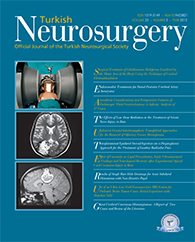2Hacettepe University, Faculty of Medicine, Department of Anatomy, Ankara, Turkey
3Ankara University, Faculty of Veterinary Medicine, Department of Surgery, Ankara, Turkey
4Hacettepe University, Faculty of Medicine, Department of Biochemistry, Ankara, Turkey DOI : 10.5137/1019-5149.JTN.5193-11.1 AIM: After acute spinal cord injury (SCI), a large number of axons are lost by a cascade of pathophysiological events known as a secondary injury. The main aim of the current study was to investigate the potential neuroprotective effects of curcumin on lipid peroxidation (LPO), neurological function, and ultrastructural findings after SCI.
MATERIAL and METHODS: Forty adult Wistar albino rats were randomized into five groups: control, SCI alone (50 g/cm weight drop), methylprednisolone sodium succinate (MPSS) (30 mg/kg), curcumin + dimethyl sulfoxide (DMSO) (300 mg/kg), and DMSO alone (0.1 mg/kg).
RESULTS: Administration of curcumin significantly decreased LPO in first 24 hours. However, there were no differences in the neurological scores of injured rats between the medication groups and the control group. Curcumin was more effective than DMSO and MPSS in reducing LPO, whereas DMSO was more effective than curcumin and MPSS in minimizing ultrastuctural changes. The results of this study indicate that curcumin exerts a beneficial effect by decreasing LPO and may reduce tissue damage.
CONCLUSION: Since ultrastructural and neurological findings does not support biochemical finding, our findings do not exclude the possibility that curcumin has a protective effect on the spinal cord ultrastructure and neurological recovery after SCI. A combination of curcumin with other vehicle may also have a considerable synergy in protecting spinal cord.
Keywords : Curcumin, Malondialdehyde, Methylprednisolone, Cord Injury, Ultrastructure, Rats




